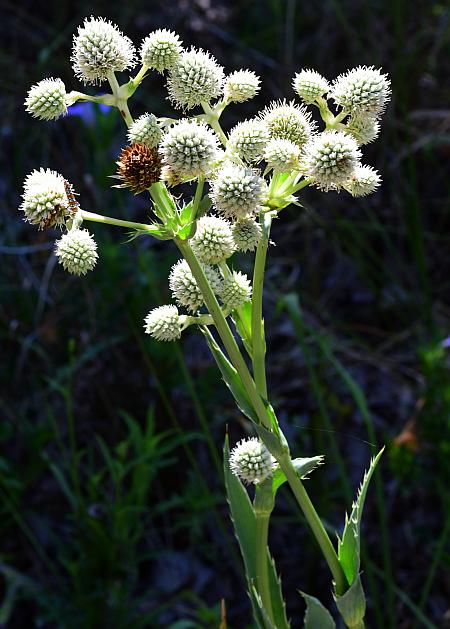Eryngium yuccifolium Michx.
Rattlesnake Master

Native
CC = 8
CW = 0
MOC = 63
© SRTurner
Eryngium yuccifolium Michx.Rattlesnake Master | |
 |
Native CC = 8 CW = 0 MOC = 63 |
© SRTurner |
|
Family - Apiaceae Habit - Perennial forb with tuberous roots, glabrous and glaucous. Stems - Ascending to erect, to 1.5 m, few-leaved, glabrous, glaucous.
Leaves - Alternate and usually basal, sessile, grasslike, sheathing, the venation parallel. Sheathing bases not inflated. Leaf blades 4-100 cm long, linear, sharply pointed at the tip, glabrous, glaucous, the margins with widely spaced, spiny or threadlike teeth, less commonly entire.
Inflorescences - Terminal globose heads 1.0-2.5 cm long, solitary or in small panicles or loose clusters, mostly long-stalked, strongly whitened, the branch points with reduced, leaflike bracts, these with spiny teeth or lobes. Bracts subtending each head 6-10, 4-16 mm long, narrowly ovate, sharply pointed at the tip, the margins entire or finely toothed. Terminal bracts absent. Individual florets sessile, each subtended by one chaffy bract, this glabrous, acute, partially enclosing the floret, to 1 cm long. Receptacle subglobose.
Flowers - Numerous, sessile, each subtended by a bractlet similar to the bracts, but 6-10 mm long. Sepals 2.5-3.0 mm long, ovate, entire. Petals 5, oblong, irregular, rounded at the tip, glabrous, white. Ovaries with appressed, lanceolate scales. Stamens 5, distinct, folded back on themselves at first and then erect and exserted. Filaments glabrous, greenish white, to 3-4 mm long. Anthers greenish, to 1.3 mm long.
Flowering - June - September. Fruits - Schizocarps 4-8 mm long, oblong in outline, with ascending, papery, lanceolate scales mostly along the angles. Habitat - Prairies, forest openings, glades, savannas. Also cultivated. Origin - Native to the U.S. Lookalikes - None. Other info. - At first glance, this distinctive species appears as an Agave or Yucca. Its true affinity with the carrot family is far from evident. It is found throughout most of Missouri, less commonly in the northwestern and southeastern counties, and throughout most of the eastern half of the continental U.S., excepting the far northeastern states. With a rather bizarre but strangely attractive appearance, it is also frequently cultivated, and does well in a garden setting. Although appearing cactuslike, the spines on the leaves are actually soft and will not pierce skin. Strong fibers in the leaves can be used as cordage to fashion woven items. The stems of the plant have a carrot-like fragrance when crushed. The common name "rattlesnake master" refers to an old (and erroneous) belief that the plant could treat a rattlesnake bite. Photographs taken at Bethel Prairie, Barton County, MO., 7-4-03, and at the Sunklands Conservation Area, Shannon County, MO., 7-26-04 (DETenaglia); also at Klondike County Park, St. Charles County, MO, 8-1-2014, Shaw Nature Reserve, Franklin County, MO, 7-27-2019, Don Robinson State Park, Jefferson County, MO, 7-13-2022, and Tucker Prairie Natural Area, Callaway County, MO (SRTurner). |